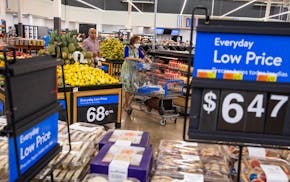Since General Mills acquired Blue Buffalo in 2018, Americans have brought home millions more dogs and cats and are spending billions more per year on their food.
It's the era of the pet parent with now 2.5 times as many pets as children in the U.S.
"It's wild, and it has really changed how people view pets," said Bethany Quam, president of General Mills' pet division. "It continues to fuel what we call humanization — if you believe they're a family member, then you want to feed them and treat them like humans."
Blue Buffalo's appeal — and the source of its growth — comes from its meat-first natural ingredient list that mirrors the clean-label trend in human food.
While Blue Buffalo is the leading all-natural pet food brand in the U.S., it makes up about 5% of the $37 billion dog and cat food market.
But the "fur baby boom" — which saw pet ownership rise at a record clip throughout the pandemic — opened a window for the brand to hook lifelong customers.
"It's about puppies and problems," Quam said about the reasons consumers choose or switch pet food brands. "The lifetime value of a pet is really high — it's kind of like toothpaste, you probably don't switch until you get married."
The $8 billion Blue Buffalo acquisition — General Mills' second-largest after Pillsbury in 2001 — and the $1.2 billion paid for Tyson's natural pet treats last year is a big bet that pet owners will increasingly look for natural food for their new and existing furry family members.
Analysts say it's already paying off; General Mills pet sales grew more than 20% between 2019 and 2021.
"We don't think the recent growth is all about a large number of pet adoptions during the height of COVID," said John Boylan, an equities analyst at Edward Jones who tracks General Mills. "Instead, we believe there is a sustainable trend of pet parents treating their pets more like humans, namely paying more attention to ingredients and premium brands."
Quam said the brand's goal is to be the first and only choice for pets and their parents.
"We are what we call a master brand," she said. "Blue Buffalo can fulfill all their needs."
Not people, still family
The humanization of pet food accelerated during the pandemic but has been building for years — and started in part with Blue Buffalo's founding 20 years ago.
"Blue Buffalo convinced millions of owners it was a necessity for true dog lovers," Harvard Business Review wrote about the brand's successful industry disruption in 2018. "The company pushed owners to draw a connection between what their families ate to avoid chronic disease and what would give their dogs the same kind of protection."
The pandemic saw more people bring home pets and caused them to spend more time together, continuing a cultural shift around the role of pets in the household.
The Nudges and True Chews treats brands, a part of the Tyson acquisition, will soon be adorned with the Blue Buffalo logo, but most of the marketing — and human food-like shapes — will remain the same.
Quam said that can help draw in Blue Buffalo buyers while keeping the existing customer base.
As with human food, natural pet brands like Blue Buffalo sell at a premium, and inflation has pushed prices even higher.
Pet food prices have risen 7% in the past year, according to the Bureau of Labor Statistics. To compare, human food is up 9.4%.
But some surveys suggest pet owners are more willing to cut personal spending before pet expenses, and as a result Quam said there hasn't been much "trading down" to less expensive alternatives.
"Rising cost inflation might not impact the pet food sector as much as others as, again, consumers increasingly shop for their pet food like they shop for food for themselves, focusing on quality ingredients and the perceived health benefits," said Boylan, the Edward Jones analyst.
New connections
Natural ingredients are key for many people buying pet food, but taste reigns supreme for the creatures consuming it.
With felines generally being pickier eaters, cat food has grown much slower than it has for dogs in the natural category.
Blue Buffalo revamped and re-released its wet cat food under the Tastefuls brand last year, replacing the Healthy Gourmet line. New packaging has also helped give the brand an edge over competitors — the plastic containers can be used to cut up servings without having to dirty a fork or knife.
"The cats must like it, because they keep coming back," Quam said.
The pandemic limited Blue Buffalo's in-person approach to building brand awareness at pet food stores, so the company created a free social media app built for pet owners that includes live text chats with pet experts and real-time feedback on product issues and the needs of pet parents.
"We do a mix of quantitative and qualitative development, but definitely the data at least prompts us know where to start," said Tricia Kinney, a vice president in the pet division. "Because what we're looking for are places that ideally others haven't really played in as much yet."
Quam said the brand, now found in 23 million households, is focusing its innovation on solving consumer problems.
"Innovation can be product package or the way you connect with your consumer, and so we've been very focused on that and we've grown incredibly," she said. "When you bring together awareness, and great products, we have nothing but confidence."
Minnesota's med spa industry rises in popularity — and with little regulation

Ramstad: Readers say Walmart won't be paying the ultimate price of Trump's tariffs

How Minnesota businesses can spot and prevent invoice fraud
No place for cryptocurrency in retirement portfolios
